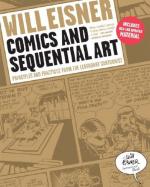
|
| Name: _________________________ | Period: ___________________ |
This test consists of 15 multiple choice questions and 5 short answer questions.
Multiple Choice Questions
1. When are the outlines determined by the artist?
(a) Before the artist decides on the action.
(b) After the rest of the comic is drawn.
(c) While the artist draws the page.
(d) After the artist decides on the action.
2. Graphic novels include reading written words and what else, for example?
(a) Pictures, maps, circuit diagrams, musical notes.
(b) Touch, taste, smell, pictures.
(c) Images, love, theory, abstraction.
(d) 3D worlds, technology, maps, music.
3. Around when did daily comic strips first appear?
(a) 1756.
(b) 1934.
(c) 1943.
(d) 1956.
4. What is the title of Chapter 4?
(a) Elements.
(b) Sequence.
(c) Narrative.
(d) Framing.
5. In "Contract with God" by Eisner, what does the stone tablet suggest?
(a) The Five Ideals.
(b) The One Principle.
(c) The Ten Commandments.
(d) The Unity of the Mind.
6. How do comics form a language?
(a) By repetitiveness.
(b) Through content.
(c) Through morphemes.
(d) By spontaneity.
7. In Eisner's third example of "Contract with God" what drips from the heavy lettering?
(a) Blood.
(b) Resin.
(c) Amber.
(d) Water.
8. The earliest use of balloons was in what culture?
(a) The Mayan culture.
(b) The Aztec culture.
(c) The Slavic culture.
(d) The Incan culture.
9. The earliest use of balloons was in what type of art?
(a) Scope.
(b) Dada.
(c) Friezes.
(d) Impressionism.
10. What is one of the two examples of time measurement Eisner mentions?
(a) Minutes.
(b) Radiation.
(c) Radiowaves.
(d) Morse code.
11. Through what must the artist seize attention and dictate the sequence?
(a) The pages.
(b) The structural thought.
(c) The sequence.
(d) The narrative.
12. What can the frame's shape or absence convey?
(a) Character development.
(b) The profession of the artist.
(c) The progression of emotion.
(d) The sound and emotion of the action.
13. Where does Eisner's second example in "Contract with God" take place?
(a) Riverbrook.
(b) The Bronx.
(c) Mount Sinai.
(d) Madison Avenue.
14. Why does Eisner analyze this particular Spirit story in Chapter 3?
(a) To show how time is realized through sequence.
(b) To demonstrate the alteration of perspective.
(c) To show how images and rhythm are disparate.
(d) To demonstrate the nature of space and width.
15. How can a panel be diagrammed?
(a) Like a sentence.
(b) Like a word.
(c) Like a song lyric.
(d) Like a railroad track.
Short Answer Questions
1. What is used to move a reader or viewer through time?
2. What tendency of the eye is an obstacle in comics?
3. What does the nature of lettering reflect about the artist?
4. After which century, did artists start to depend on expressions, postures, and backdrops?
5. What conventions do comics rely on?
|
This section contains 417 words (approx. 2 pages at 300 words per page) |

|




